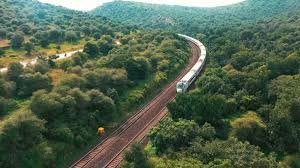Why in the News?
- The government released the long-delayed Synchronous All India Elephant Estimation (SAIEE) 2021–25, giving a DNA-based population estimate of 22,446 Asian elephants (range: 18,255–26,645).
- The exercise used a new, genetics-based methodology (first of its kind for India) for creating a new baseline for future monitoring and conservation planning.
Key Highlights
- Why the survey was done and its timing
- India undertook a nationwide elephant census between 2021 and 2025 to update numbers across major landscapes. The report was released in October 2025 after delays caused by complex genetic analysis and data validation.
- Survey design and field work (what teams actually did)
- Field teams walked forest trails covering nearly 7 lakh km, visited over 3.1 lakh dung plots, and recorded signs of elephants using the M-Stripes app.
- Forests were mapped using satellite images to check how good the habitat is for elephants and how much human activity affects it.
- New scientific method introduced
- For the first time at scale, scientists used genetic mark–recapture: DNA was extracted from over 21,000 dung samples to identify individual elephants by their genetic fingerprints.
- These identified individuals (about 4,065 unique elephants) and statistical mark–recapture models were combined with ground and satellite data to estimate overall abundance.
- Results and why they differ from 2017 figures
- The average estimate is 22,446 elephants, lower than the 2017 estimate (27,312). The report stresses that the two figures are not directly comparable because of the methodological change and thus treats 2025 as a new baseline.
- The statistical range of the new estimate is 18,255 to 26,645, reflecting uncertainty from sampling and modelling.
- Regional and state-wise distribution
- Major landscapes: Western Ghats (11,934), North Eastern Hills & Brahmaputra plains (6,559), Shivalik & Gangetic plains (2,062), Central India & Eastern Ghats (1,891).
- Top states: Karnataka (6,013), Assam (4,159), Tamil Nadu (3,136), Kerala (2,785), Uttarakhand (1,792), Odisha (912). Smaller fragmented herds occur in Madhya Pradesh, Maharashtra and several northeastern states.
- Key threats identified across landscapes
- Habitat loss and fragmentation from plantations, farmland fencing and development projects.
- Infrastructure barriers – railway lines, roads and power corridors are disrupting traditional corridors.
- Mining pressures in central India.
- Invasive plant species, encroachment, and human-elephant conflict are other major threats.
| Genetic Mark–Recapture A population-estimation method that uses genetic “tags” (from tissue or dung) to identify individuals. Re-sampling over time lets researchers estimate population size statistically. It reduces observer bias and is especially useful for species without distinctive markings. Mark–Recapture Models Mathematical models that estimate population size by comparing the proportion of “marked” (identified) individuals in repeated samples. Genetic identification serves as the “mark” in DNA-based studies, enabling robust inference when sample effort is large. |
Conservation Status and Legal Protection
- The Asian elephant is considered Endangered by the IUCN, meaning it’s at high risk of disappearing.
- In India, it gets the strongest legal protection under Schedule I of the Wildlife Protection Act, 1972.
- It is also listed in Appendix I of CITES, which means trading elephant parts internationally is strictly banned.
Conservation Efforts in India
- India has taken several steps to protect elephants:
- Project Elephant (1992): A major program to protect elephants and their natural homes.
- Elephant Corridors Programme: Helps elephants move safely by protecting 101 key paths across the country.
- Gaj Yatra Campaign: A national campaign to raise awareness and encourage peaceful living between people and elephants.
- Technology Tools: Uses satellite maps, camera traps, and mobile apps like M-Stripes to track elephant numbers and reduce conflicts.
Implications for India
- A new scientific baseline: DNA-based estimates provide a more robust starting point for monitoring trends and evaluating conservation interventions.
- Policy and funding prioritisation: Regions with high elephant numbers (Western Ghats, NE) must be prioritized for corridor protection and anti-poaching/enforcement resources.
- Reconnect broken elephant habitats: Protect and restore the natural paths (called corridors) that elephants use to move between forests. This helps elephants avoid getting trapped in small areas, keeps their genetic diversity healthy, and prevents local extinction of small groups.
- Human-wildlife conflict management: States must scale up compensation, early-warning systems, and community-based mitigation to reduce losses and backlash.
- Global responsibility and diplomacy: India, hosting the majority of Asia’s elephants, must lead regional conservation cooperation and meet international biodiversity commitments.
Challenges and Way Forward
| Challenge | Way Forward |
| Methodological transition & comparability | Accept 2025 as a new baseline; run overlapping methods in next round to calibrate trend comparisons. |
| Data gaps in remote/Northeast areas due to difficult terrain and limited elephant signs | Conduct focused follow-up surveys, increase local training and repeat sampling to fill coverage gaps. |
| Habitat fragmentation and infrastructure barriers | Map and legally protect corridors; apply wildlife-sensitive designs for roads/rail; use overpasses/underpasses. |
| Mining, plantations and land-use change | Enforce land-use zoning, require environmental clearances, and promote off-reserve conservation incentives. |
| Human–elephant conflict & community livelihoods | Expand compensation, promote crop protection, community stewardship programs and alternative livelihoods. |
Conclusion
The SAIEE 2021–25 is a landmark because it introduces DNA-based science to national elephant monitoring and sets a credible baseline of 22,446 elephants. The figure highlights urgent needs; secure habitat connectivity, better enforcement, local engagement and repeated, robust monitoring; if India is to ensure long-term survival of its elephants and coexistence with people.
| EnsureIAS Mains Question Q. Examine the importance of the SAIEE 2021–25 genetic-based elephant estimation for conservation policy in India. Discuss how the findings should shape habitat connectivity, infrastructure planning and human–elephant conflict management. (250 Words) |
| EnsureIAS Prelims Question Q. With reference to India’s SAIEE 2021–25 elephant estimation, consider the following statements: 1. The 2025 estimate of 22,446 elephants is directly comparable with the 2017 estimate and shows a definitive nationwide decline. 2. The new survey used genetic mark–recapture based on DNA from dung to identify individual elephants. 3. The survey combined ground surveys, satellite habitat mapping and genetic analysis to produce population estimates. 4. The Western Ghats was identified as India’s largest elephant landscape in the new estimate. Which of the statements given above are correct? Answer: C. 2, 3 and 4 only Explanation: Statement 1 is Incorrect: The 2025 figure arises from a new DNA-based methodology and is designated a new baseline. Because methods changed, direct comparison with the 2017 number is not valid to claim a definitive decline without calibrated trend analyses. Statement 2 is Correct: Researchers used genetic mark–recapture, extracting DNA from dung samples to identify about 4,065 unique elephants and apply statistical models to estimate total abundance. This method is useful where individuals lack unique physical markings. Statement 3 is Correct: The exercise had a three-phase approach — extensive foot surveys (ground), satellite mapping for habitat and human footprint, and laboratory genetic analysis — combined to model elephant numbers. Statement 4 is Correct: The Western Ghats was reported as the largest stronghold with 11,934 elephants in the SAIEE 2021–25 results, making it the top landscape by population. |
Also Read | |
| UPSC Foundation Course | UPSC Daily Current Affairs |
| UPSC Monthly Magazine | CSAT Foundation Course |
| Free MCQs for UPSC Prelims | UPSC Test Series |
| ENSURE IAS NOTES | Our Booklist |





